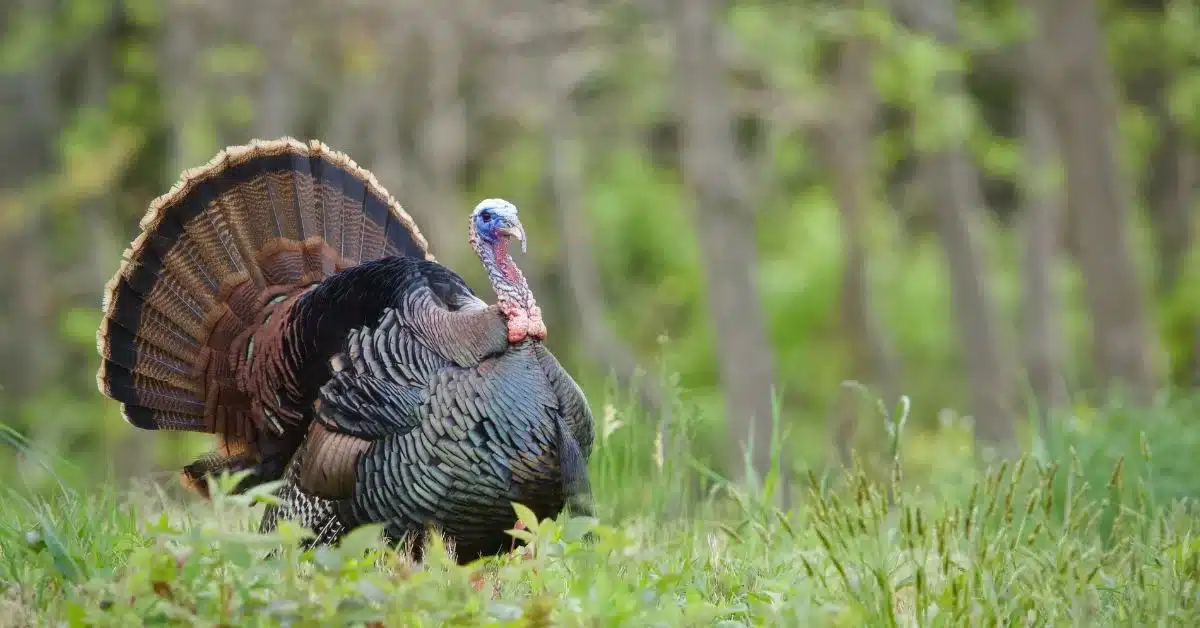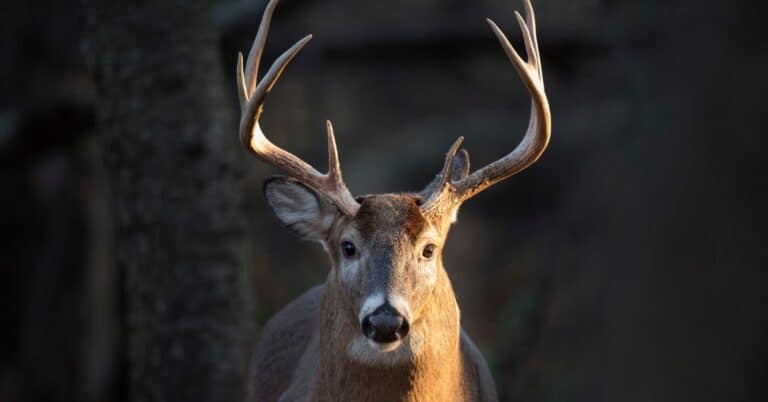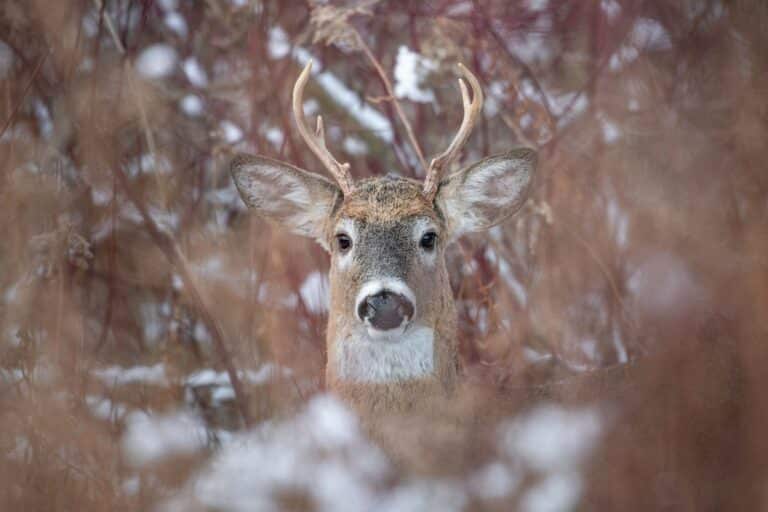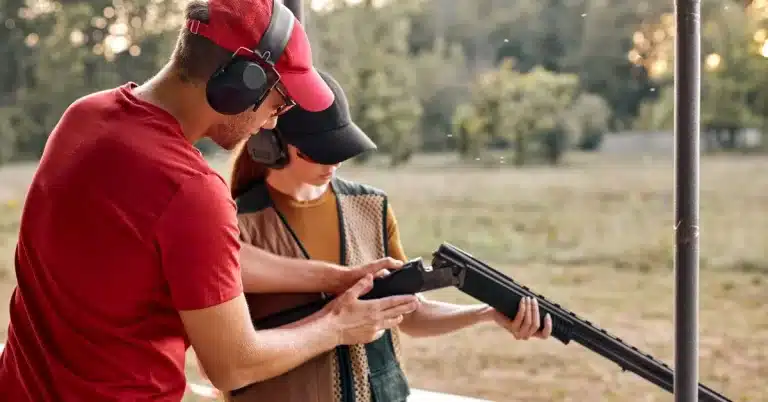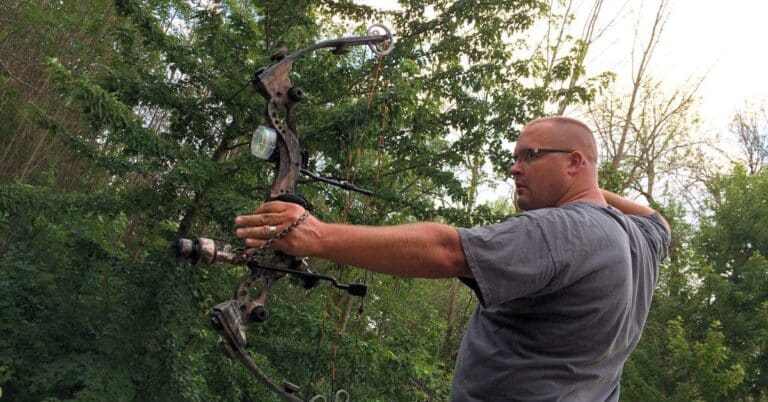Turkey Bow Hunting Tips for Beginners
Deer season is over and the spring season has arrived. You might be itching for your next hunting adventure. Maybe you are a shotgun hunter ready for a challenge. Or you have driven by a field of turkeys and wondered what it would be like? I love the Michigan outdoors and find ways to keep my skills and passion alive by sharing bow-hunting tips. Springtime is a great season to try hunting turkeys for the first time.
I’ve been successful many times hunting on public land, as well as private land. I even set my sights on a specific Tom turkey to complete my Michigan Grand Slam with a bow. However, I wanted to interview my longtime friend, and turkey-hunting mentor, Doug. He has shown me everything I know about turkeys.
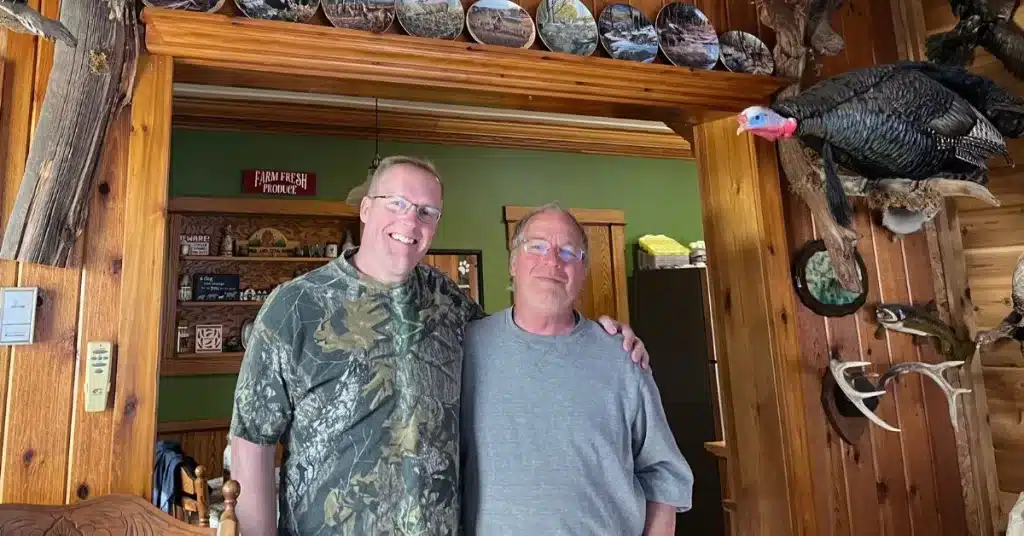
Doug has experience hunting all over the United States for turkeys, but he loves his home state of Michigan. His first hunt dates back to 1994 and he’s harvested at least 30 turkeys, but he’s lost count! The walls in his home prove it. His advice is full of great tips for the best way to hunt a turkey. We hope you’re excited to try turkey hunting!
Michigan turkey history
The eastern wild turkey was reintroduced to Michigan in the 1950s and became more prevalent here in Ottawa County in the late 1990s. Doug said Wildlife management offices had “tried introducing different domestic birds but they had too many diseases.” The birds from lower Michigan have also migrated north, but the winters are tougher. So they are attracted to food resources and farmers can help their survival by offering extra feeding options.
“I hunted the very first season and took a bird in the very first hour. I was really close to being the first one who shot a bird in Ottawa County. It’s mounted right up there on my wall.”
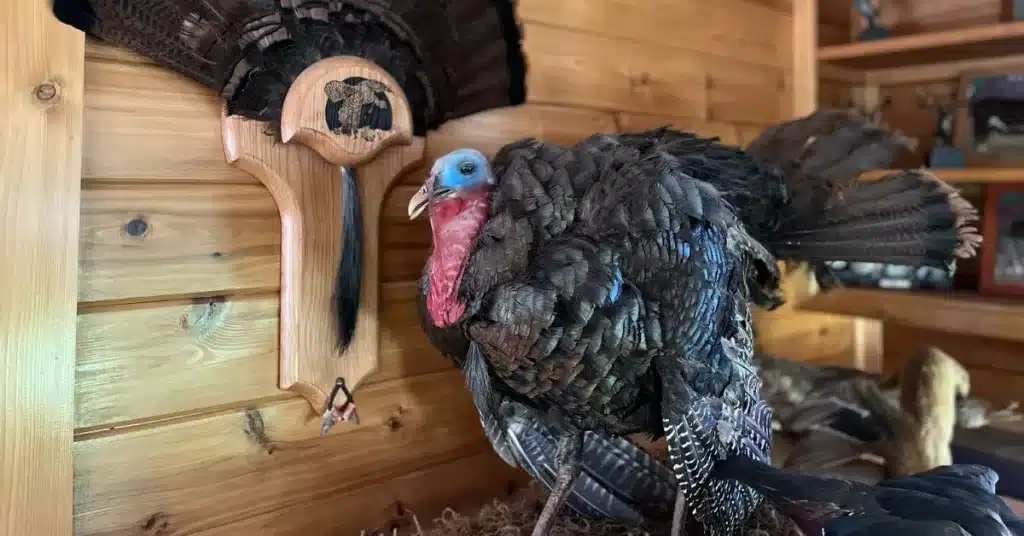
Turkey eyesight
If you are familiar with deer hunting, then you know you can often stay undetected from a deer if you remain still. Deer will try to get you to move by bobbing its head and looking away. If you move it will look back at you.
Deer can also smell you if you are downwind. But turkeys are different, they don’t have a strong sense of smell.
Doug shared, “A turkey is the prime food source for the coyotes all winter. They have no questions and they have very good eyesight. If they see any amount of movement, and it’s not another turkey, they’re gone. They don’t hang around and question what they see. They’re out of there because their buddies have been dinner for prey too many times.”
Spring and Fall Turkey Hunting
“In the springtime, you listen for them and you try to call them in. And in a lot of states in the fall, they can use the dog,” says Doug. “The dog will go in there and scatter them. And then the dog comes back and you put them under a camouflage blanket.” Some guys will hunt this way and wait for the birds to come back to the group to shoot them.
Turkey bow hunting tips
Scouting and planning your turkey hunt
Doug’s best turkey bow hunting tip is to “get up in the morning before the season and go out and listen. They usually start gobbling in the tree where they sleep in the middle of March.” This is about the same time you might hear other songbirds starting to chirp in spring.
“When it starts to get a little warmer, like this year, you might hear them talking in early March,” Doug added.
He advised being aware of your noise. Being stealthy and quiet in your scouting will prevent the birds from getting spooked. You don’t want to pressure them or have them disappear from the area you are scouting. Doug also recommends scouting long-range. If you’d like to invest more time or money in your turkey hunt, then consider a trail camera.
Glassing for turkey
Due to the amazing eyesight of turkeys, binoculars or a spotting scope are a key piece of equipment for scouting and hunting. You’ll want to preview locations from a distant vantage point to survey the land. Glassing (looking through binoculars) will allow you to search large areas and increase your chance of spotting turkeys without spooking them. The last thing you want is to find a great location and then scare them away.
Where to set up your hunting spot
Learn turkey patterns by scouting, glassing, and studying their behavior. Then you’ll know where they are for an early morning hunt and find the right spot. Some birds will fly down from their tree and start eating in one field but then have patterns of following the hens.
For a good shot opportunity, set up where you know the turkeys are going to be moving to. Think about where they will end their walk, instead of where they start. You’ll also want to consider an effective range for a bow, which is 30 to 40 yards. Then park your car far away, walk around the field, and loop back to your spot. This way you can avoid spooking the birds
Camouflage is key for turkey hunting
“You’ll want to wear camo from head to toe, including a face mask. I like to head net because of my glasses,” said Doug.
You won’t need hunter’s safety orange for turkey season. Their eyesight will spot you right away. But Doug added, “Once you get a bird and you’re carrying it out, you can use little orange flags over the bird on your back, so you don’t get shot carrying your bird out of the field.”
Hunting turkey from a blind
New and beginner turkey hunters may want to start with a pop-up blind. Turkeys “pay absolutely no attention to ground blinds,” says Doug. But ground blinds make more sense when you are hunting with a gun. “I like a dark background for the blind. You’ll want to wear your head and neck camo because a lot of times a turkey can look inside and your face just glows. You should set up a camouflage blind after you know where they are.”
Once you have a few seasons under your belt and you feel more comfortable, you can start hunting right from natural cover. Most experienced bow hunters will hunt without a blind and just sit up against a tree. Doug likes to hunt from the edges of fields.
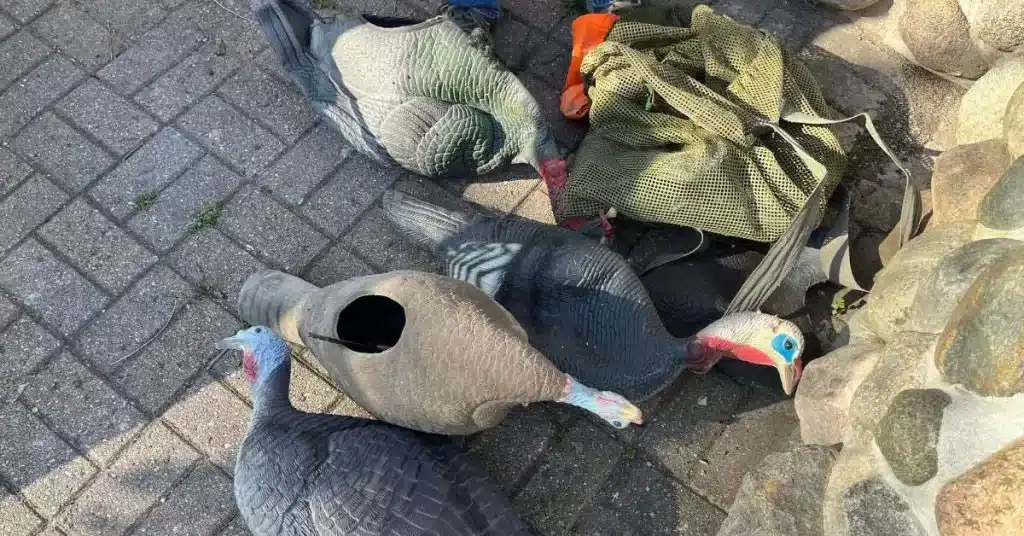
What is the basic archery gear for turkey hunting?
You can check out our complete bow hunting checklist but for spring turkey or a fall hunt, the right equipment includes:
- Camo from head to toe
- Binoculars or a spotting scope
- Different turkey calls
- Turkey-specific broadheads
- Ground blind if you are a beginner
- Turkey vest with seat cushion for the more experienced
- Turkey decoys as you grow your gear
- Thermacell or bug spray
Turkey calls
There are many different styles of turkey calls including locators, box, friction, and mouth calls. Friction calls also have various materials like slate or glass. “I just stick with the friction box. It’s louder and you can get them to react so you know where they are,” shared Doug.
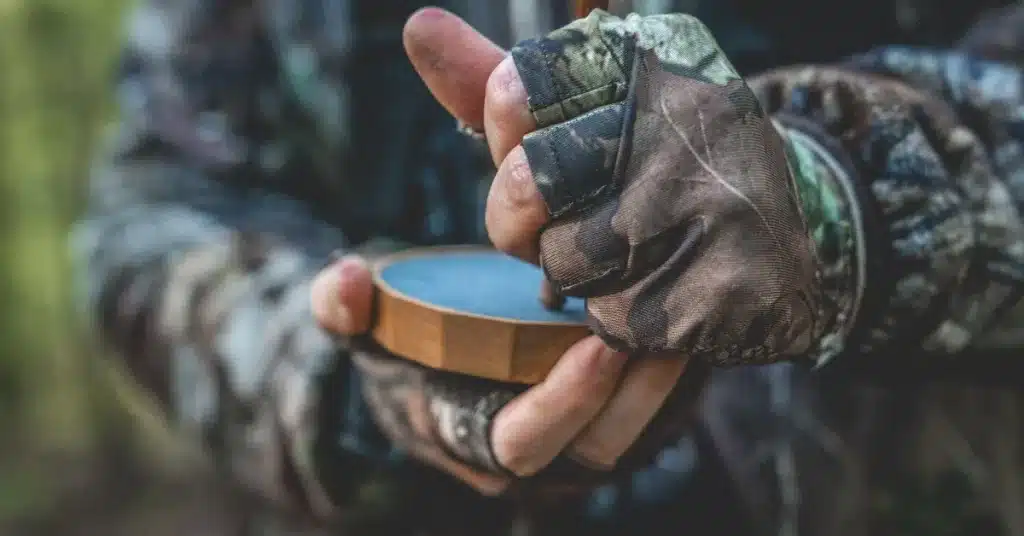
“I’ve always been loyal to Primos calls. I like the sound of them and I can usually get a turkey to do a full strut.” This type of call would be good for a beginner.
Another tip is to learn the sounds that the hens make. If you can copy the sound of the loudest hen, you can make her angry and want to come find you. They are very territorial birds.
Box Call:
This type is a box-shaped wooden or synthetic material that makes turkey sounds when you slide or tap the lid against the sides. The goal is to mimic a hen yelp, clucks, purrs and gobbles of turkeys.
Slate Call:
Another name for this is a pot call. It’s circle-shaped and has a slate or glass surface in a pot-like base. You will strike or rub across the surface to create realistic turkey sounds. You can adjust the sound by changing the pressure or speed.
Mouth Call:
These are also known as a diaphragm call and are put in your mouth. It’s a small latex or similar material and requires air pressure to make a wide range of vocalizations that sound like a turkey. You might prefer this type of call if you want your hands to be free.
Locator Calls:
This tool can often be used to find turkeys at the beginning of your hunt so you know where to sit. It does not make turkey sounds, but rather sounds of other birds like owl hoots, hawk screams, or crow caws. These owl and crow call noises will draw out the male turkeys and reveal their location.
Bow broadheads
When hunting with a bow, there are different types of broadheads to consider. Most commonly used are expandable blades that have long razor blades that have a larger than normal cutting diameter. For consideration, bow hunters either aim for a headshot or a vital area shot when hunting turkey. Depending on what shot placement you prefer to take determines what type of broadhead to use.
Turkey decoys
Beginner hunters don’t need to invest in decoys right away. Doug says “You can hunt without them, especially in the early season because the birds will come in easier. Later in the season, once they’ve bumped into a couple of decoys and they were shot or didn’t like the look of them, it will be more challenging to draw them in later in the season.”
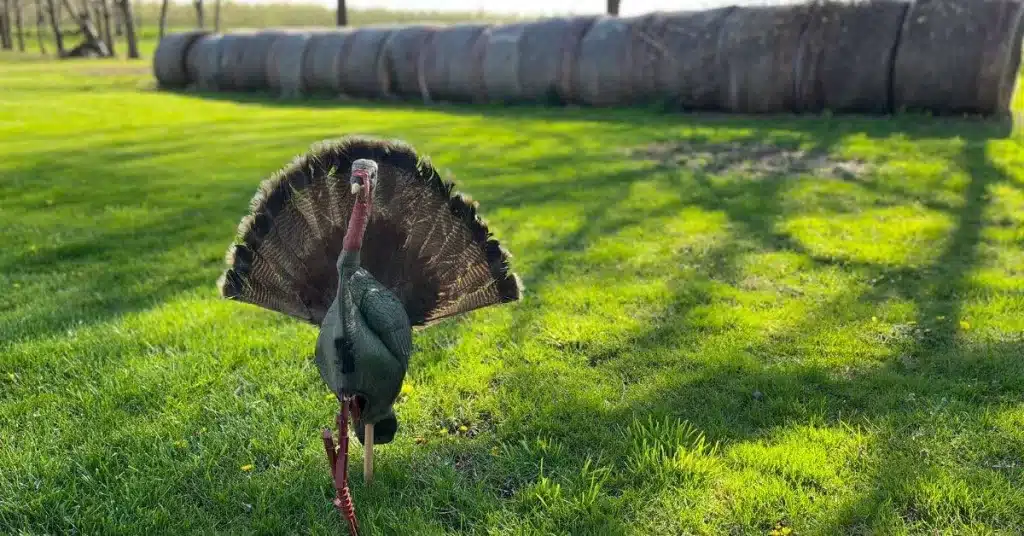
There are different types, such as hen turkeys, jakes, and realistic decoys. Doug is infamous for his “ugly” decoys. He combines a skinny, ugly Jake decoy with a real tail fan he made on a stake. Because the decoy is small but shows its tail feathers, other turkeys will get mad that it’s trying to show its dominance. The turkey bow hunting tip of attracting dominant turkeys with an imposter is genius!
Doug says that his ugly decoy “really upsets the older birds. They see that scrawny little Turkey trying to move in on their hens and they get really mad.”
It’s important to be careful about how you place your decoys. “You wouldn’t want to put them straight out in front of you. If somebody is sneaking through the woods and they see it, they will shoot in your direction and that can be dangerous.”
Turkey bow hunting: frequently asked questions
Can you bait for turkeys?
“No, there’s no baiting. But turkeys will be attracted to leftover corn from last year’s harvest. Baiting turkey is against the law here.” Baiting is against the law in Michigan. Looking for public or private land near agricultural fields is going to give you a better chance.
How can you spot a turkey?
“If you listen to turkey coming through the dry leaves, they sound a lot like a person. Except they will walk for a little bit, and then they scratch looking for something to eat.” A good tip is to listen carefully and wait for the scratching noise after a few steps.
Dominant male turkeys will also show off their feathers. Sometimes you can spot a turkey in the field by the tips of their feathers fanned out. You might also see multiple turkeys together, but only one has the feathers visible because he’s the dominant bird.
Doug shared that fanning their feathers is a way for a dominant turkey to say “Look at me. I’m bigger.” But the other birds will defend him and look for danger while he’s busy trying to sweet talk the ladies.” He continued “If you shoot him and he falls over and starts flopping on the ground. The other turkeys are not his buddies anymore. The two will jump on him and beat him because they want to become the dominant bird.”
When there is a group of male turkeys, Doug added “That’s how you can shoot two if you’re sitting with two people. Because even though it is a gunshot, they forget about it quickly. They are too busy kicking him and making noise with their wings.”
What is the best time of day for turkey hunting?
Morning
Pre-dawn and first light are often the best time for a successful turkey hunt. Finding a roosted bird is the key. This means you’ve located where the turkeys sleep in their “roost trees”, it’s best if you are in place before they wake up and fly down to the ground. Doug says it’s “a big performance when you’re turkey hunting and you see them come in.”
Once they are on the ground they will start their morning routine of foraging for food, gobbling to establish their territory, socializing and grooming. Male turkeys might strut and fluff out their feathers to attract the females and then they will start to roam and continue to look for food or water.
Late Afternoon Hunt
The late afternoon can also be a good time because turkeys will be active again looking for food before they fly back to their roost trees. And if it’s mating season, this can also be a good time of day.
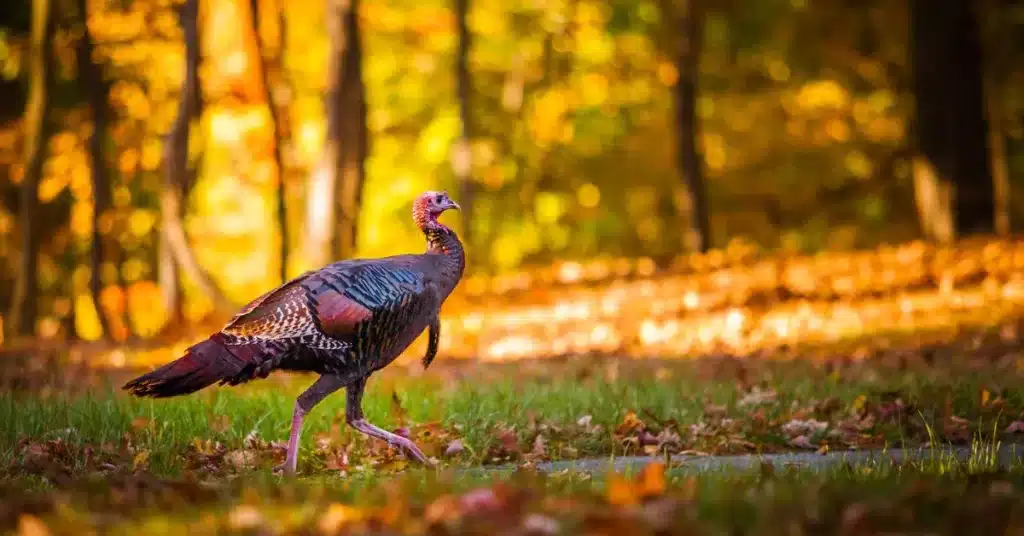
Doug recalls a time when he was set up on the west side of a field edge. The turkeys could not see him because the sun was in their eyes the whole afternoon. But once the sun went behind the trees, and the shade hit the group, he was able to draw one in by making it mad. He had been gobbling a little back and forth but then made just the right sound and angered the bird.
“The turkey showed signs of being in love with a white head. But when I gobbled, and he turned around and saw my decoy with his feathers fanned out, his head turned red. He got mad and went into a dead run towards me starting about 75 yards away. My wife shot him at 15 yards.”
Check for legal time
Something to know about turkey hunting is that there are very specific times when you can hunt and when you have to top. Doug says turkeys are “in the trees for their own safety. They fly up at night so they don’t get hunted by coyotes and stuff like that. Once they are in their roost, you are done hunting. Technically, five minutes before they fly up.”
You can check the Spring Turkey Regulations for the hunting hours which is very specific down to the minute.
What is the most common mistake turkey hunters make?
Doug sees a lot of hunters move too early. “If you’re calling to a bird and it goes quiet. You just wait. I usually try to sit there for an hour, just to make sure he’s not sneaking in. If you get impatient and stand up too early, you’ll give yourself away.”
Where do you shoot a turkey?
Shot placement is important because the turkey vitals are smaller than deer and about the size of a softball. They have a small kill zone compared to big game animals. The most challenging shot with a bow is the head/neck shot. If the turkey is facing you, then aim for the spot just under the beard at the base of the neck. This will be a fast and ethical kill.
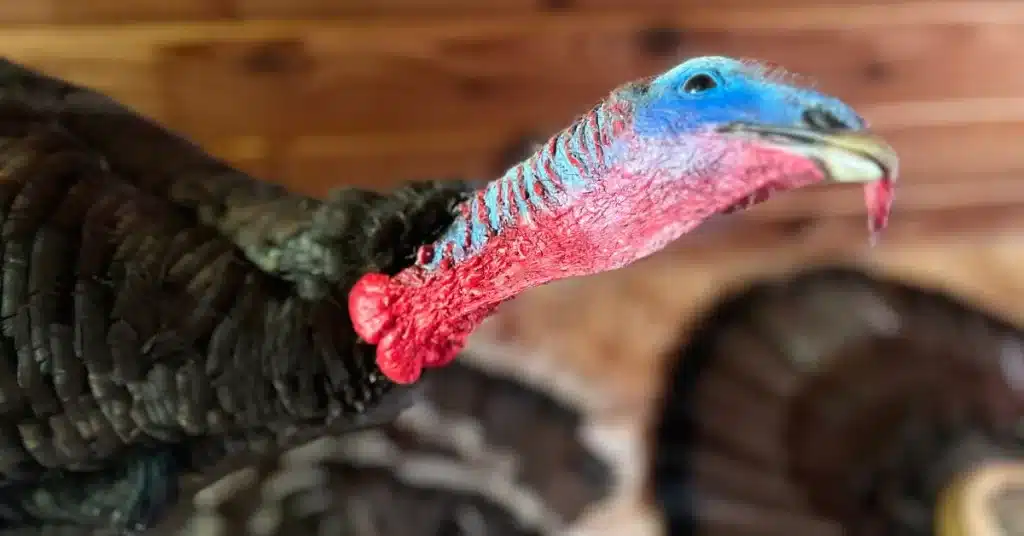
If you need to take a broadside shot, make sure you have broad heads meant to penetrate the heavy feathers and breasts. This article has excellent detailed explanations about shot placement for turkey hunting.
Doug’s final turkey bow hunting tip
“Try not to let the pressure of getting one make you do dumb stuff. Just enjoy the spring and be able to hear the sounds, it’s amazing,” says Doug. “You can listen to the hens talk. If you are in a situation where mature Toms are with some hens, there’s usually a dominant hen there. And she’ll usually be the loudest bird. Learn to copy her and talk back and forth. But then make your call louder. It’s fun to interact with them and use sound to draw them out.”

